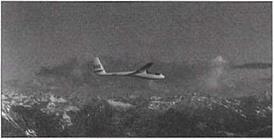Soaring on Silent Wings: Gliding
|
|
For some, the beginning of summer is not signaled by the first pitch of a baseball team or by the beginning of school vacation. No, for those who love gliders and glider flying, summer truly begins the day they see the first glider circling overhead in the gentle grip of a sun – powered upward rush of air.
In most regions of the United States, glider flying is a sport that must be enjoyed during the few warm months when the sun’s warmth and steady but benign winds provide the energy gliders require in order to spend hours at a time in silent, birdlike flight.
The Glider and the Plane
Perhaps the best way to start looking into the world of gliding is by comparing the glider to the airplane.
When you look at a glider resting beside a conventional powered airplane, one of the first things you notice is how long and skinny the wings are. Compared to those of a glider, the broad wings of an airplane look like a pair of barn doors.
The glider also sits very low to the ground. In fact, it sits so low that you might not be certain it has any landing gear at all. But if you bend down, you can see the curve of the rubber tire peeping out of a little cave where it mostly hides out of the airstream. That’s your first sign that glider designers are obsessed with reducing air resistance. They never stop fussing about drag and how to reduce it.
|
|
Max Karst flies his ASW15B over the mountaintops of the Cascade Range east of Seattle.
(Vince Miller)
|
PJane Talk |
Sleek modern gliders are a far cry from the pioneering gliders that Otto Lilrenthal and the Wright brothers built in the very early days of flight (See Chapters 1 and 2 for more on these great aviation innovators.) Early experimental gliders were largely responsible for perfecting the shape of wings and the engineering techniques used to make aircraft strong and durable. That meant they were often unsophisticated and bulky. Lilienthal didn’t survive the experimental phase of his research into flight, but the Wright brothers picked up his baton and refined his gliders into the first airplanes. All fixed-wing aviators trace their legacy to Lilienthal and his gliders.
You also notice how the glider is tipped over onto one side. It rests on one wingtip or the other because there’s only the one tire under the cockpit. There’s nothing like the conventional airplane’s two main landing gear plus a nose wheel to stabilize it on the ground.
What’s more, you see that the body and skin of the glider are amazingly ”clean“— that is, there are no parts of it that jut into the air. The skin, which is usually made of Fiberglas or some other very light material, is buffed and polished until it gleams. The light weight of the Fiberglas is a testament to the glider designers’ aversion to excess weight, which is almost as pathological as their fear of drag.
That careful attention to reducing drag and weight is due to the final difference between the glider and the conventional airplane: The glider has no engine. How is it possible, you ask, for a plane to fly without an engine? Read on!
Thin Is In
|
By the Book Aspect ratio is an aerodynamics formula that measures how skinny or squat a wing is. It divides the wing’s span by its front-to-back chord. That comparison means that a narrow wing, like a glider’s, will have a higher aspect ratio than the wing of a powered airplane. |
Because gliders don’t carry their own source of power, they are designed to waste as little energy as possible. One of the glider design’s hallmarks is its long, skinny wings, which have a far higher aspect ratio than the wings of most powered airplanes. This special shape helps reduce induced drag, the kind of drag that is created as a by-product of lift. (For a review of the forces of flight, including lift and drag, turn back to Chapters 7, ”How Airplanes Fly, Part 1: The Parts of a Plane,“ and 8, ”How Airplaines Fly, Part 2: The Aerodynamics of Flight.“)















